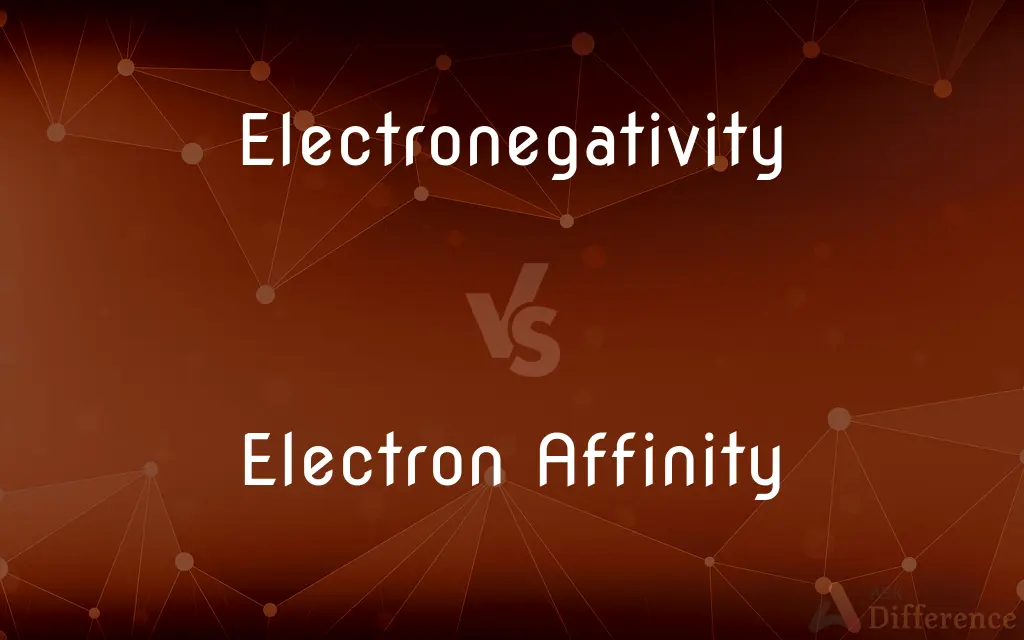Electronegativity vs. Electron Affinity — What's the Difference?
Edited by Tayyaba Rehman — By Fiza Rafique — Published on November 26, 2023
"Electronegativity is an atom's pull for electrons in a bond, while Electron Affinity is the energy change when an atom gains an electron."

Difference Between Electronegativity and Electron Affinity
Table of Contents
ADVERTISEMENT
Key Differences
Electronegativity refers to the measure of the tendency of an atom to attract a bonding pair of electrons. On the other hand, Electron Affinity is the amount of energy released when an electron is added to a neutral atom or molecule in the gaseous state to form a negative ion.
Electronegativity is a dimensionless quantity and is often used to predict the nature of chemical bonds in a molecule: whether they are ionic, covalent, or polar covalent. In contrast, Electron Affinity provides quantitative measures, typically expressed in joules per mole (J/mol) or electronvolts (eV), indicating the likelihood of an atom to accept an electron.
Electronegativity values depend on atom’s atomic number and distance between the valence electrons and the nucleus. In contrast, Electron Affinity is affected by the atom's electronic configuration, particularly by the stability of the resulting ion after the electron addition.
Electronegativity is often utilized in understanding the type of bond formation between atoms in a molecule, helping chemists in understanding molecular behavior and properties. Conversely, Electron Affinity is primarily used to explore atomic and molecular stability and the tendency for chemical reactions to occur, particularly those involving ion formation.
Both Electronegativity and Electron Affinity are fundamental concepts in chemistry, essential for predicting the chemical behavior of atoms. While Electronegativity helps determine how electrons are shared in a molecule, Electron Affinity considers the energy changes involved when an electron is added to an atom.
ADVERTISEMENT
Comparison Chart
Definition
Tendency of an atom to attract electrons in a bond.
Energy released when an atom accepts an electron.
Units
Dimensionless (no units).
Joules per mole (J/mol) or electron volts (eV).
Usage in a sentence
"Fluorine's high Electronegativity makes it highly reactive."
"Chlorine has a high Electron Affinity, leading to negative ion formation."
Grammatical form
Noun; used as a subject or object in sentences.
Noun; used as a subject or object in sentences.
Application
Predicting bond type and molecular polarity.
Understanding energy changes in ion formation.
Compare with Definitions
Electronegativity
Electronegativity is a fundamental chemical property that helps predict bonding behavior.
High Electronegativity differences between atoms often lead to ionic bonds.
Electron Affinity
Electron Affinity is a measure of the stabilizing effect experienced when an electron is added to an atom.
Sulfur's lower Electron Affinity compared to oxygen is due to its larger size.
Electronegativity
Electronegativity is a measure of an atom's ability to attract and hold onto electrons.
Because of oxygen's high Electronegativity, it forms polar covalent bonds.
Electron Affinity
Electron Affinity is often used to predict the properties of chemical compounds.
Knowing the Electron Affinity values is important for predicting molecular behavior.
Electronegativity
Electronegativity is an indication of how strongly an atom can pull electron density towards itself.
Elements with high Electronegativity tend to form negative ions.
Electron Affinity
Electron Affinity is the energy change when an electron is added to a neutral atom.
The Electron Affinity of halogens is high, explaining their reactivity.
Electronegativity
Electronegativity is used to anticipate the molecular polarity and reactivity.
The Electronegativity difference between hydrogen and oxygen explains water's polarity.
Electron Affinity
Electron Affinity quantifies an atom's tendency to form a negative ion.
High Electron Affinity usually indicates non-metallic character.
Electronegativity
Electronegativity values are central to several theoretical models of bonding and molecular structure.
Electronegativity values are crucial in molecular orbital theory.
Electron Affinity
Electron Affinity reflects the likelihood of an atom accepting an electron.
With low Electron Affinity, noble gases are known for their lack of reactivity.
Electronegativity
(chemistry) The tendency, or a measure of the ability, of an atom or molecule to attract electrons when forming bonds.
Electronegativity
(chemistry) the tendency of an atom or radical to attract electrons in the formation of an ionic bond
Common Curiosities
What does Electron Affinity indicate?
Electron Affinity indicates the energy change that occurs when an electron is acquired by a neutral atom.
How does Electronegativity affect bonding?
High Electronegativity differences lead to ionic bonds, moderate differences to polar covalent bonds, and small differences to non-polar covalent bonds.
Are Electronegativity values the same for all atoms?
No, Electronegativity varies among elements; it generally increases across a period and decreases down a group.
Why do atoms with high Electron Affinity form anions?
High Electron Affinity means energy is released when an electron is added, making anion formation energetically favorable.
What is Electronegativity?
Electronegativity is a measure of an atom's ability to attract and bond with electrons.
Does Electronegativity change in a chemical reaction?
No, Electronegativity is an intrinsic property of an element and doesn't change in a chemical reaction.
Does Electron Affinity affect reactivity?
Yes, elements with higher Electron Affinity values are often more reactive, especially with elements that easily lose electrons.
Is Electron Affinity the same for all elements?
No, Electron Affinity varies, with some elements releasing energy upon gaining an electron and others requiring energy.
What is the most electronegative element?
Fluorine is the most electronegative element, with a value of 3.98 on the Pauling scale.
How is Electron Affinity measured?
Electron Affinity is typically measured using spectroscopic techniques or calculated from theoretical models and computational methods.
Which element has the highest Electron Affinity?
Chlorine has the highest Electron Affinity, meaning it's highly favorable for it to gain an electron and form an anion.
Can Electronegativity predict molecule polarity?
Yes, differences in Electronegativity between atoms in a molecule can predict if the molecule will be polar or non-polar.
How does Electronegativity relate to chemical reactivity?
Elements with high Electronegativity are generally more reactive because they strongly attract electrons.
Is Electron Affinity always a negative value?
Not always; Electron Affinity is negative if energy is released when an atom gains an electron, but it can be positive if energy is absorbed.
What's the key difference between Electronegativity and Electron Affinity?
Electronegativity measures an atom's attraction for electrons in a bond, while Electron Affinity measures the energy change when an atom gains an electron.
Share Your Discovery

Previous Comparison
Cash Book vs. Cash Account
Next Comparison
Feet vs. Square FeetAuthor Spotlight
Written by
Fiza RafiqueFiza Rafique is a skilled content writer at AskDifference.com, where she meticulously refines and enhances written pieces. Drawing from her vast editorial expertise, Fiza ensures clarity, accuracy, and precision in every article. Passionate about language, she continually seeks to elevate the quality of content for readers worldwide.
Edited by
Tayyaba RehmanTayyaba Rehman is a distinguished writer, currently serving as a primary contributor to askdifference.com. As a researcher in semantics and etymology, Tayyaba's passion for the complexity of languages and their distinctions has found a perfect home on the platform. Tayyaba delves into the intricacies of language, distinguishing between commonly confused words and phrases, thereby providing clarity for readers worldwide.












































